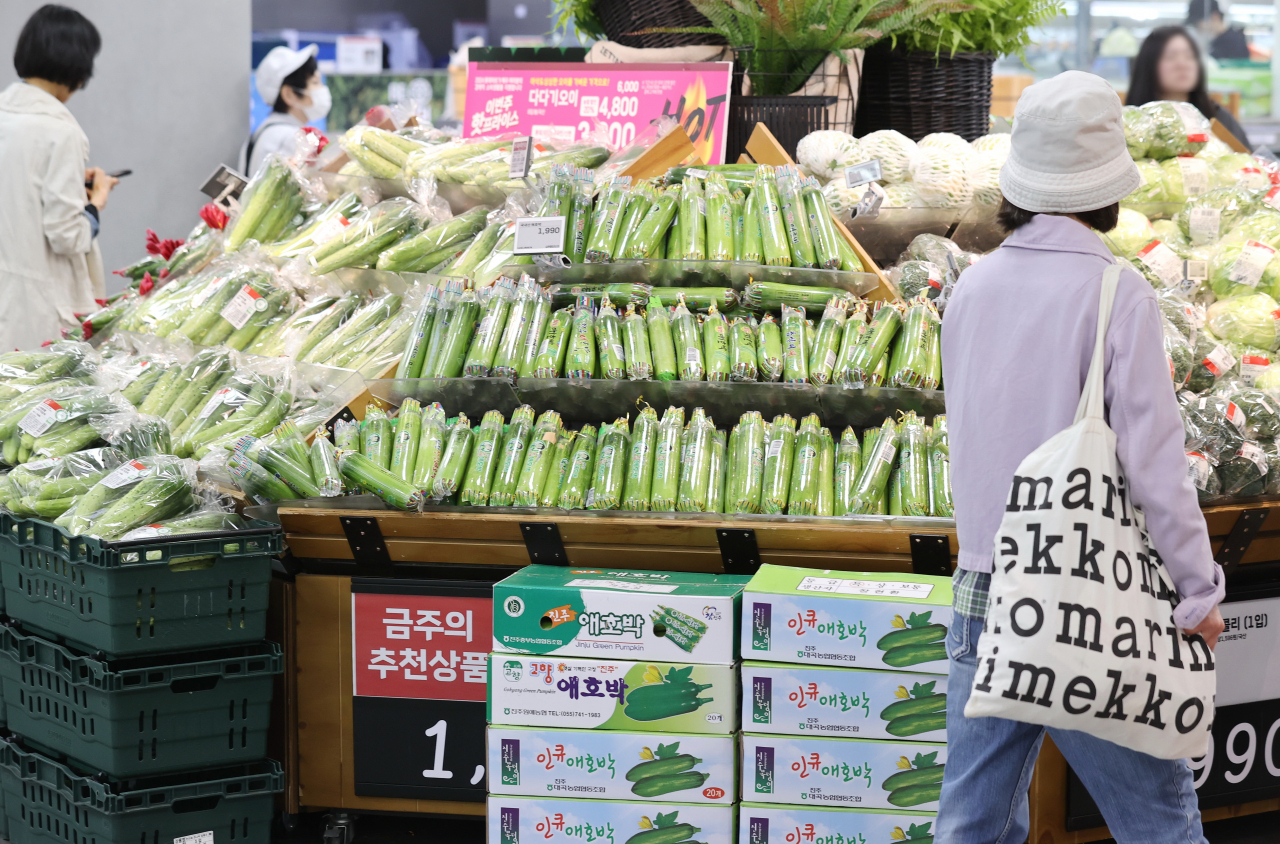Inflation eases in April, continues ‘bumpy’ ride

A person shops for groceries at a supermarket in central Seoul, Thursday. (Yonhap)
South Korea's inflation fell to the 2 percent range as the country’s directive to lower price growth goes down a “bumpy” path on fluctuations in the oil and agricultural prices, data showed Thursday.
Consumer prices, a key metric of inflation, rose by 2.9 percent in April, marking a 0.2 percentage point decrease from the 3.1 percent reading shown in both March and February, according to the data from Statistics Korea.
It is the first time for the figure to come down to the 2 percent range since the 2.8 percent growth seen in January.
“The prices of petroleum products, which remain volatile due to the conflict in the Middle East, did not rise as much as expected,” Kong Mi-sook, a senior official at Statistics Korea, said at a press briefing held Thursday.
“The on-month drop came from the reduced price growth of agricultural, livestock and fishery products,” Kong said.
As it was projected, the inflation progress in Korea is likely to move on a “bumpy” trajectory, pressured by the volatility in prices of fuel and agricultural products as well as the fluctuating Korean won’s value against the US dollar.
BOK Gov. Rhee Chang-yong has projected the road to 2 percent inflation to be “bumpy,” meaning price growth will continue to fluctuate until it comes down to the target rate of 2 percent.
“The slowdown of inflation in April is of an expected level,” the central bank assessed Thursday.
“The growth of consumer prices is projected to ease mainly on the core inflation side, but the uncertainty is grave, considering the fluctuation of fuel prices related to the geopolitical risks and the strong prices of agricultural products.”
The core inflation, excluding food and energy prices, has been easing off steadily. It rose by 2.3 percent in April, marking a 0.1 percentage point fall from the 2.4 percent growth seen in the previous month, after increasing by 2.5 percent in January and February.
Meanwhile, the US Federal Reserve kept its key rate pat for the sixth consecutive time Wednesday, maintaining the benchmark interest rate between 5.25 and 5.5 percent.
With the US Fed’s rate freeze, the Korea-US rate is maintained at up to 2 percentage points. The BOK has kept the key rate at 3.5 percent for more than a year since February 2023.
In response to the US Fed’s rate decision, Finance Minister Choi Sang-mok vowed to take "bold" measures to stabilize the market in case of excessive volatility.
“The economic fundamentals remain strong in Korea, as shown in rising exports and a rebound in private consumption,” Finance Minister Choi Sang-mok said at a governmental meeting held Thursday.
Volatility in share prices and exchange rates has escalated in the local financial market with the rising tension in the Middle East, but the market remains stable overall with the continued inflow of foreign funds in securities and the reduction in the credit spread in the money market, the attendees at the meeting viewed.
“Bold measures will come into place to stabilize the market if it exhibits excessive volatility,” Choi said.
Meanwhile, the Bank of Korea is set to hold a rate-setting meeting on May 23. The market expects the central bank to maintain the 3.5 percent base rate.
By Im Eun-byel (silverstar@heraldcorp.com)
EDITOR'S PICKS
- [KH Explains] Hyundai-backed Motional’s struggles deepen as Tesla eyes August robotaxi debut
- Kepco to raise electricity prices as total debt soars past W200tr
- Starbucks Korea to speed up hiring process
- Hyundai, KAIST develop world’s 1st technology to extend lifespan of LFP battery
- LX Pantos teams up with China's Sinotrans for US, Europe expansion
- Miracell showcases stem cell technology at Milan trade show
- KITA, FKI chiefs call for mutual benefit from US investment
- [Herald Interview] For US overnight stockbroker Blue Ocean, golden hour falls on Sunday 8 p.m.






![[KH Explains] Hyundai-backed Motional’s struggles deepen as Tesla eyes August robotaxi debut](http://res.heraldm.com/phpwas/restmb_idxmake.php?idx=141&simg=/content/image/2024/05/16/20240516050605_0.jpg)






![[Herald Interview] For US overnight stockbroker Blue Ocean, golden hour falls on Sunday 8 p.m.](http://res.heraldm.com/phpwas/restmb_idxmake.php?idx=141&simg=/content/image/2024/05/16/20240516050545_0.jpg)

